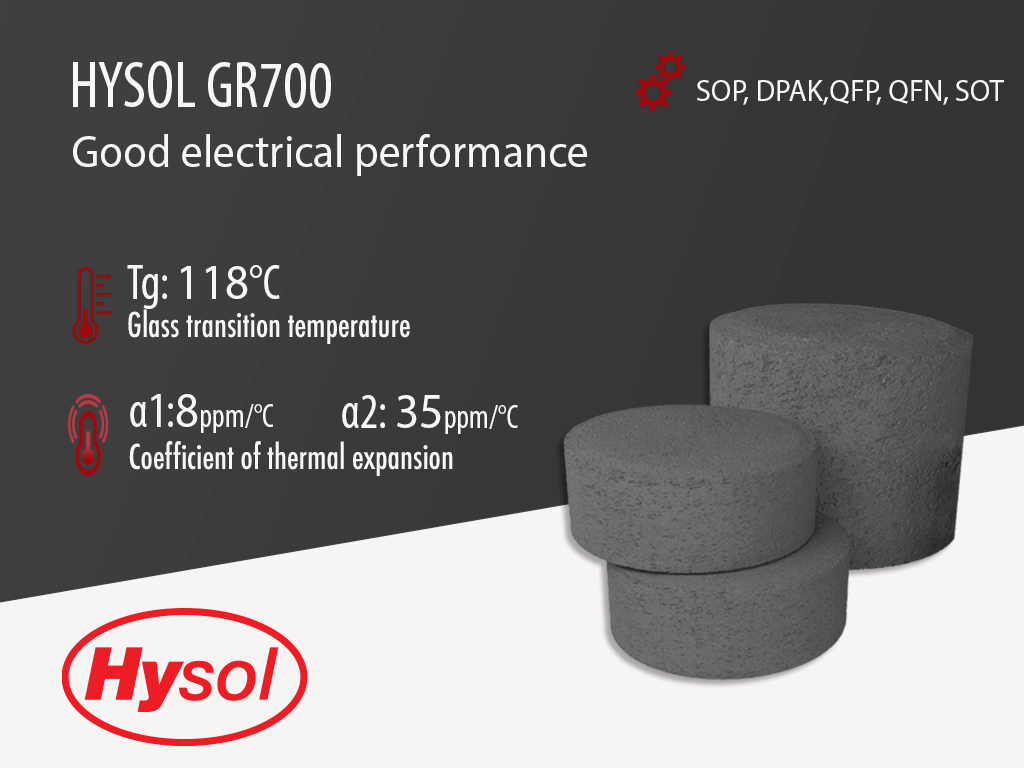Hysol GR700 | Black Epoxy Mold Compound
- Low stress
- For high power devices
- Good electrical performance
Product Description
Hysol GR700, is a halogen free, black, silica filled (87% filler weight) semiconductor grade green epoxy molding compound designed for SOP MSL1. This low stress, high adhesion compound has very good electrical performance and is a proven, commercially available product code. This is a product that has achieved MSL 1 and its comparative tracking index (CTI) is 600V.
Hysol GR700 is a technologically advanced, halogen free, green epoxy molding compound with excellent electrical performance, designed for high power devices applications with low moisture absorption requirements. Typical use can be in SOP, DPAK,QFP, QFN, SOT semiconductor packages. Furthermore, it meets UL 94 V-0 flammability at 1/8 inch thickness..
HYSOL GR700 has been formulated to provide the best possible moldability and as wide a molding latitude as possible. Although molding and curing conditions will vary from situation to situation.
Available versions:
- GR700 (STD)
- GR 700 C3D
- GR700 C4C
- GR700 P2
Technical Specifications
| General Properties | |||||||||
| Color Color The color | Black | ||||||||
| Filler Content | 87 % | ||||||||
| Specific Gravity Specific Gravity Specific gravity (SG) is the ratio of the density of a substance to the density of a reference substance; equivalently, it is the ratio of the mass of a substance to the mass of a reference substance for the same given volume. For liquids, the reference substance is almost always water (1), while for gases, it is air (1.18) at room temperature. Specific gravity is unitless. | 1.97 | ||||||||
| |||||||||
| Thermal Properties | |||||||||
| Glass Transition Temperature (Tg) Glass Transition Temperature (Tg) The glass transition temperature for organic adhesives is a temperature region where the polymers change from glassy and brittle to soft and rubbery. Increasing the temperature further continues the softening process as the viscosity drops too. Temperatures between the glass transition temperature and below the decomposition point of the adhesive are the best region for bonding. The glass-transition temperature Tg of a material characterizes the range of temperatures over which this glass transition occurs. | 118 °C | ||||||||
| Thermal Conductivity Thermal Conductivity Thermal conductivity describes the ability of a material to conduct heat. It is required by power packages in order to dissipate heat and maintain stable electrical performance. Thermal conductivity units are [W/(m K)] in the SI system and [Btu/(hr ft °F)] in the Imperial system. | 0.9 W/m.K | ||||||||
| UL 94 Rating UL 94 Rating Flammability rating classification. It determines how fast a material burns or extinguishes once it is ignited. HB: slow burning on a horizontal specimen; burning rate less than 76 mm/min for thickness less than 3 mm or burning stops before 100 mm V-2: burning stops within 30 seconds on a vertical specimen; drips of flaming particles are allowed. V-1: burning stops within 30 seconds on a vertical specimen; drips of particles allowed as long as they are not inflamed. V-0: burning stops within 10 seconds on a vertical specimen; drips of particles allowed as long as they are not inflamed. 5VB: burning stops within 60 seconds on a vertical specimen; no drips allowed; plaque specimens may develop a hole. 5VA: burning stops within 60 seconds on a vertical specimen; no drips allowed; plaque specimens may not develop a hole | V-0 | ||||||||
| |||||||||
| |||||||||
| Electrical Properties | |||||||||
| Volume Resistivity Volume Resistivity Volume resistivity, also called volume resistance, bulk resistance or bulk resistivity is a thickness dependent measurement of the resistivity of a material perpendicular to the plane of the surface. | 6.0x1016 Ohms⋅cm | ||||||||
| Chemical Properties | |||||||||
| Moisture absorption | 0.26 % | ||||||||
| |||||||||
| Physical Properties | |||||||||
| Spiral Flow @ 175°C | 132.08 cm | ||||||||
| Mechanical Properties | |||||||||
| Molded Shrinkage | 0.2 % | ||||||||
| |||||||||
| |||||||||
| |||||||||
| |||||||||
| Curing Conditions | |||||||||
| Transfer Pressure | 40-85 kg/cm2 | ||||||||
| Transfer Time | 8-15 s | ||||||||
| |||||||||
| |||||||||




